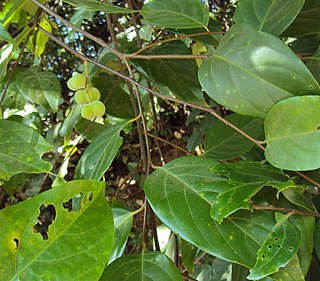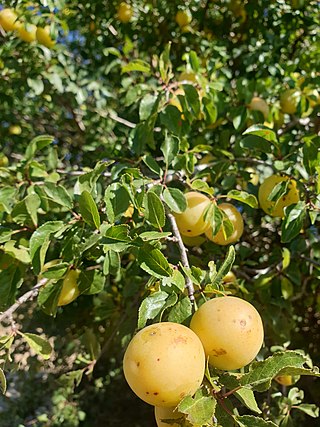
Prunus spinosa, called blackthorn or sloe, is a species of flowering plant in the rose family Rosaceae. The species is native to Europe, western Asia, and regionally in northwest Africa. It is locally naturalized in New Zealand, Tasmania, and the Pacific Northwest and New England regions of the United States.

Prunus padus, known as bird cherry, hackberry, hagberry, or Mayday tree, is a flowering plant in the rose family. It is a species of cherry, a deciduous small tree or large shrub up to 16 metres (52 ft) tall. It is the type species of the subgenus Padus, which have flowers in racemes. It is native to northern Europe and northern and northeast Asia, and is grown as an ornamental in North America.

The scarce swallowtail is a butterfly belonging to the family Papilionidae. It is also called the sail swallowtail or pear-tree swallowtail.

Prunus serotina, commonly called black cherry, wild black cherry, rum cherry, or mountain black cherry, is a deciduous tree or shrub of the genus Prunus. Despite being called black cherry, it is not very closely related to the commonly cultivated cherries such as sweet cherry, sour cherry and Japanese flowering cherries which belong to Prunus subg. Cerasus. Instead, P. serotina belongs to Prunus subg. Padus, a subgenus also including Eurasian bird cherry and chokecherry. The species is widespread and common in North America and South America.

Prunus salicina, commonly called the Japanese plum or Chinese plum, is a small deciduous tree native to China. It is now also grown in fruit orchards in Vietnam, Korea, Japan, Israel, the United States, and Australia.

Prunus pensylvanica, also known as bird cherry, fire cherry, pin cherry, and red cherry, is a North American cherry species in the genus Prunus.

Prunus incisa, the Fuji cherry, is a species of flowering plant in the family Rosaceae, which gets its scientific name from the deep incisions on the leaves. It is an endemic species in Japan and grows wild in Kantō, Chūbu and Kinki regions. It is also called Fuji cherry because it grows especially heavily around Mount Fuji and Hakone. A dainty slow-growing, early white-flowering cherry, this century-old cultigen from Hondo, Japan is highly regarded as an ornamental but the wood has no industrial value. It is hardy to -20 °C, and crossed with Prunus speciosa, has yielded the cultivar Prunus 'Umineko'. It is in the ornamental section Pseudocerasus of the cherry subgenus Cerasus of the genus Prunus. Ma et al. classified it in a group with Prunus nipponica.
Prunus korshinskyi is a species of Prunus in the family Rosaceae. It was first discovered in Syria, and is also locally native in Turkey and southeastern Europe. It is threatened by habitat loss. It is a deciduous shrub growing to 3.5 m tall, related to the almond.
Prunus arborea is a species of plant in the family Rosaceae. It is found in Indonesia, Malaysia, Singapore, and Thailand.

Prunus ceylanica is a species of plant in the family Rosaceae. It is a resident species to Sri Lanka and India.

Prunus cocomilia is a species of plum commonly called Italian plum. It is native to Albania, Croatia, Greece, southern Italy, Montenegro, North Macedonia, Serbia, and western Turkey.
Prunus grisea is a species of plant in the family Rosaceae. It is found in Malaysia, the Philippines, Singapore, and Taiwan.
Prunus javanica is a species of plant in the family Rosaceae. It is found in India, Indonesia, Malaysia, and Myanmar.
Saurauia herthae is a species of plant in the Actinidiaceae family. It is endemic to Ecuador. Its natural habitats are subtropical or tropical moist lowland forests and subtropical or tropical moist montane forests. It is threatened by habitat loss.

Prunus fremontii is a North American species of plants in the rose family, known by the common name desert apricot. It takes its scientific name from John C. Frémont. It is found in northern and western Baja California especially, mostly Pacific and western, and the adjacent area of southern California. It also occurs in northern Baja California Sur.

Prunus avium, commonly called wild cherry, sweet cherry, gean, or bird cherry is a species of cherry, a flowering plant in the rose family, Rosaceae. It is native to Europe, Anatolia, Maghreb, and Western Asia, from the British Isles south to Morocco and Tunisia, north to the Trondheimsfjord region in Norway and east to the Caucasus and northern Iran, with a small isolated population in the western Himalaya. The species is widely cultivated in other regions and has become naturalized in North America and Australia.

Prunus caroliniana, known as the Carolina laurelcherry, Carolina cherry laurel, Carolina cherry, or Cherry laurel, is a small evergreen flowering tree native to the lowlands of Southeastern United States, from North Carolina south to Florida and westward to central Texas. The species also has escaped into the wild in a few places in California.

Prunus brigantina, called Briançon apricot, Briançon plum, marmot plum, and Alpine apricot, is a wild tree species native to France and Italy. Its fruit is edible and similar to the commercial apricot P. armeniaca, but it is smooth unlike apricots. An edible oil produced from the seed, 'huile des marmottes', is used in France.

Prunus myrtifolia, called the West Indies cherry or myrtle laurel cherry, is a New World species of shrubs in the family Rosaceae.

Prunus davidiana is a species in the genus Prunus in the family Rosaceae. It is also known by the common names David's peach and Chinese wild peach. It is native to China, preferring to grow in forests and thickets, on slopes in mountain valleys, and in waste fields, from 800 to 3200 m. It is resistant to frost, and to a number of pests and diseases of cultivated peach, and is the subject of many studies for the genetic improvement of peaches.















